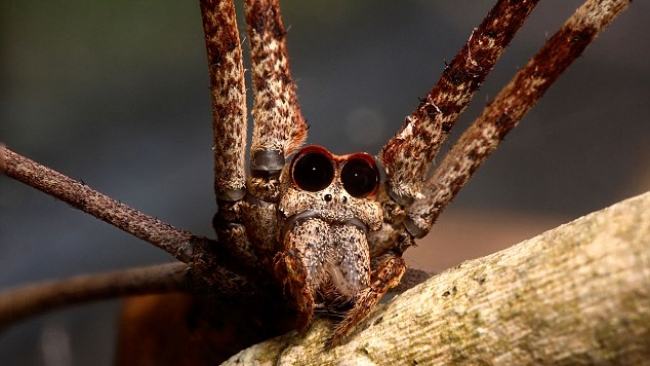The spider with NIGHTVISION goggles

Arachnid uses its enlarged eyes to help it hunt prey on the ground at night Most spiders have a cluster of eight eyes that help them target and capture their prey. But staring out like two huge black holes, two of the ogre-faced spider's eyes have become abnormally enlarged. Now a new study has revealed these huge peepers allow the spider, also known as Deinopis spinosa, or net-casting spider, to hunt for prey at night. The Deinopis spinosa spider has the largest eyes of all known arachnids. While at a glance they appear to have just two eyes, they actually have eight eyes like other species, but the large posterior median eyes are extremely enlarged. Researchers has long suspected the creatures may have used these to give them an edge during the hours of darkness, but a link has never been proved. Now a news study by the University of Nebrasca-Lincoln has found that these massive eyes allow the spider to hunt its prey on the ground at night. Other spiders tend to hunt in the air, casting nets to capture flying prey. But in the ogre-faced spider - so called due to its ugly features - it strikes its insect prey from the front. The spiders' extraordinary vision system helps it do this. As prey that live on the ground, such as crickets, tends to be bigger, it tends to also be of higher nutritional value to the spider. This sort of prey is normally out of reach for most web-building spiders. The researchers also concluded that the nocturnal spider's enlarged eyes allow them to remain active solely at night, avoiding numerous predators in the day. Predators that inhabit the spider's surroundings during the day include song birds, parasitoid wasps and jumping spiders. The researchers think the risk of being eaten or parasitised by predators in the day has played a huge role in their evolution. The spiders were tested the spiders by conducting both field and laboratory foraging trials. Writing in the journal Royal Society Biology Letters, Jay Strafstrom, a biologist at the University of Nebrasca-Lincoln and his colleagues who conducted the research, said: 'We have shown that a nocturnal predator heavily invested in low-light level vision through extreme sensory structures receives significant benefits from these specializations in the form of more and potentially higher quality prey.' Read more: http://www.dailymail.co.uk/sciencetech/article-3595122/The-spider-NIGHTVISION-goggles-Arachnid-uses-enlarged-eyes-help-hunt-prey-ground-night.html#ixzz48zVRf1ZF Follow us: @MailOnline on Twitter | DailyMail on Facebook
Source: Daily Mail
Wed 18 May 2016 at 09:41




